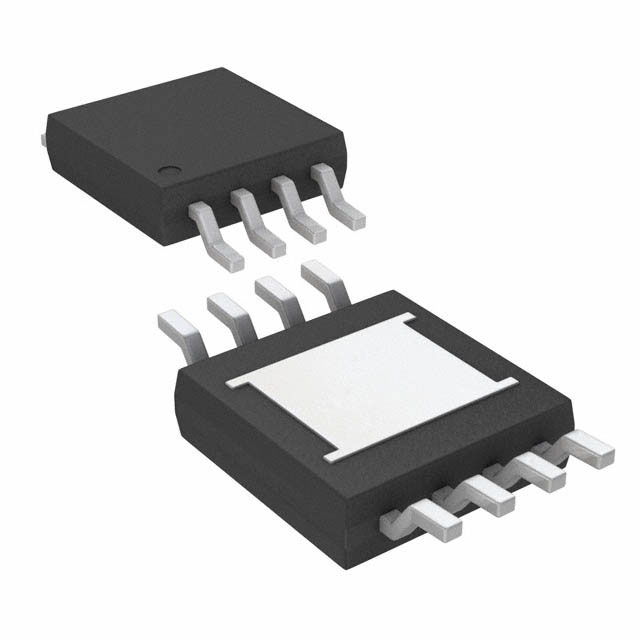Consulte las especificaciones para obtener detalles del producto.

LTC6269IMS8E-10#TRPBF
Product Overview
Category
The LTC6269IMS8E-10#TRPBF belongs to the category of operational amplifiers (op-amps).
Use
This op-amp is commonly used in various electronic circuits for amplification and signal conditioning purposes.
Characteristics
- Low noise: The LTC6269IMS8E-10#TRPBF offers low input-referred noise, making it suitable for applications requiring high precision.
- High bandwidth: With a wide bandwidth, this op-amp can handle high-frequency signals accurately.
- Low power consumption: The LTC6269IMS8E-10#TRPBF operates at low power, making it energy-efficient.
- Rail-to-rail inputs and outputs: It supports input and output voltage ranges that span from the negative supply rail to the positive supply rail.
- Small package size: This op-amp is available in an MSOP-8 package, which is compact and suitable for space-constrained designs.
Packaging/Quantity
The LTC6269IMS8E-10#TRPBF is typically packaged in reels or tubes. Each reel or tube contains a specific quantity of op-amps, usually 250 or 1000 units.
Specifications
- Supply Voltage Range: ±2.5V to ±6V
- Input Offset Voltage: 10μV (maximum)
- Gain Bandwidth Product: 10MHz
- Slew Rate: 7V/μs
- Input Bias Current: 1pA (maximum)
- Operating Temperature Range: -40°C to 125°C
Detailed Pin Configuration
The LTC6269IMS8E-10#TRPBF has a standard pin configuration as follows:
Pin 1: V-
Pin 2: IN-
Pin 3: IN+
Pin 4: V+
Pin 5: OUT
Pin 6: NC (No Connection)
Pin 7: V-
Pin 8: GND
Functional Features
- High precision amplification: The LTC6269IMS8E-10#TRPBF provides accurate amplification of input signals with low distortion.
- Wide dynamic range: It can handle a wide range of input signal amplitudes without significant degradation in performance.
- Stable operation: This op-amp maintains stability even when driving capacitive loads, ensuring reliable circuit operation.
- Low power consumption: The low power requirements make it suitable for battery-powered applications.
Advantages and Disadvantages
Advantages
- Low noise performance enables high-precision applications.
- Wide bandwidth allows accurate amplification of high-frequency signals.
- Rail-to-rail inputs and outputs provide flexibility in signal handling.
- Compact package size facilitates space-constrained designs.
Disadvantages
- Limited supply voltage range compared to some other op-amps.
- Higher input offset voltage compared to certain precision op-amps.
Working Principles
The LTC6269IMS8E-10#TRPBF operates based on the principles of differential amplification. It amplifies the voltage difference between its two input terminals, providing an amplified output signal. The internal circuitry ensures stability, low noise, and high bandwidth performance.
Detailed Application Field Plans
The LTC6269IMS8E-10#TRPBF finds applications in various fields, including:
- Sensor signal conditioning: It can amplify and condition signals from sensors such as temperature sensors, pressure sensors, and strain gauges.
- Audio amplification: This op-amp is suitable for audio amplifiers, preamplifiers, and headphone amplifiers.
- Instrumentation and measurement: It can be used in data acquisition systems, oscilloscopes, and other measurement equipment.
- Active filters: The LTC6269IMS8E-10#TRPBF is suitable for active filter circuits, allowing precise frequency response shaping.
Detailed and Complete Alternative Models
- AD8628: This op-amp offers similar characteristics and performance to the LTC6269IMS8E-10#TRPBF.
- OPA2188: Another alternative with comparable specifications and functionality.
- LT1677: This op-amp provides low noise and high precision, making it a viable alternative.
These alternative models can be considered based on specific application requirements and availability.
Word count: 520 words
Enumere 10 preguntas y respuestas comunes relacionadas con la aplicación de LTC6269IMS8E-10#TRPBF en soluciones técnicas
Sure! Here are 10 common questions and answers related to the application of LTC6269IMS8E-10#TRPBF in technical solutions:
Q: What is the LTC6269IMS8E-10#TRPBF? A: The LTC6269IMS8E-10#TRPBF is a high-speed, low-power operational amplifier (op-amp) manufactured by Linear Technology.
Q: What is the voltage supply range for LTC6269IMS8E-10#TRPBF? A: The voltage supply range for LTC6269IMS8E-10#TRPBF is typically between 2.7V and 5.5V.
Q: What is the bandwidth of LTC6269IMS8E-10#TRPBF? A: The bandwidth of LTC6269IMS8E-10#TRPBF is 10MHz.
Q: What is the input offset voltage of LTC6269IMS8E-10#TRPBF? A: The input offset voltage of LTC6269IMS8E-10#TRPBF is typically around 0.5mV.
Q: Can LTC6269IMS8E-10#TRPBF operate with a single power supply? A: Yes, LTC6269IMS8E-10#TRPBF can operate with a single power supply as long as it falls within the specified voltage range.
Q: What is the input bias current of LTC6269IMS8E-10#TRPBF? A: The input bias current of LTC6269IMS8E-10#TRPBF is typically around 1nA.
Q: Is LTC6269IMS8E-10#TRPBF suitable for low-power applications? A: Yes, LTC6269IMS8E-10#TRPBF is designed to be low-power, making it suitable for battery-powered or energy-efficient devices.
Q: Can LTC6269IMS8E-10#TRPBF drive capacitive loads? A: Yes, LTC6269IMS8E-10#TRPBF has a high output current capability, allowing it to drive capacitive loads without significant degradation in performance.
Q: What is the input voltage range of LTC6269IMS8E-10#TRPBF? A: The input voltage range of LTC6269IMS8E-10#TRPBF extends from the negative supply rail to the positive supply rail.
Q: Is LTC6269IMS8E-10#TRPBF suitable for precision applications? A: While LTC6269IMS8E-10#TRPBF offers good performance, it may not be the best choice for ultra-high precision applications due to its moderate input offset voltage and bias current.
Please note that the answers provided here are general and may vary depending on specific operating conditions and datasheet specifications. It's always recommended to refer to the official datasheet and consult with technical experts for accurate information.

